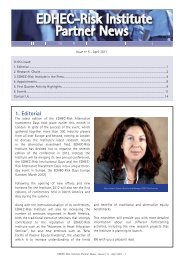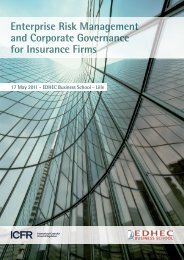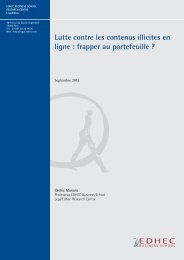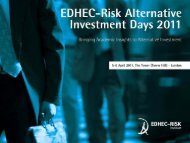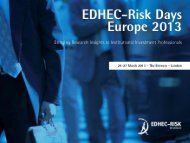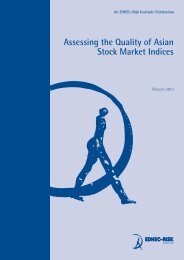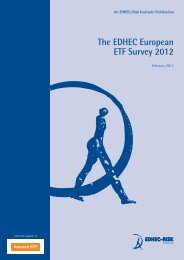Smart Beta 2.0 - EDHEC-Risk
Smart Beta 2.0 - EDHEC-Risk
Smart Beta 2.0 - EDHEC-Risk
Create successful ePaper yourself
Turn your PDF publications into a flip-book with our unique Google optimized e-Paper software.
1. The <strong>Risk</strong>s of <strong>Smart</strong> <strong>Beta</strong> Strategies<br />
lead investors to analyse the robustness<br />
conditions of the performance displayed.<br />
In the area of specific risk, two competing<br />
effects, namely parameter estimation risk<br />
and optimality risk, should be taken into<br />
account.<br />
In this document, we will describe these<br />
two dimensions of specific risk for an equity<br />
portfolio construction strategy according<br />
to the following decomposition, and we<br />
refer the reader to Martellini, Milhau and<br />
Tarelli (2013) for more details. 11<br />
Total specific risk =<br />
parameter estimation risk<br />
+ optimality risk (1)<br />
Parameter estimation risk: <strong>Risk</strong> of<br />
errors in parameter estimates<br />
Parameter estimation risk relates to the<br />
risk of an imperfect estimation of the<br />
required parameters. Due to the presence<br />
of estimation errors on expected return,<br />
volatility and correlation parameters,<br />
portfolios that rely on Maximum Sharpe<br />
Ratio (MSR) optimisation based on sample<br />
estimates typically perform poorly out<br />
of sample (DeMiguel, Garlappi and Uppal<br />
(2009). Particularly critical is the presence<br />
of errors in expected return parameter<br />
estimates, given that such estimates are<br />
more noisy compared to risk estimates<br />
to a lack of convergence of samplebased<br />
expected return estimators (Merton<br />
(1980)), and optimisation procedures are<br />
more sensitive to errors in expected return<br />
parameters versus errors in risk parameters<br />
(e.g., Chopra and Ziemba (1993)). 12<br />
In this context, one first natural approach<br />
to addressing the concern over sensitivity<br />
to errors in parameter estimates consists of<br />
improving parameter estimates typically by<br />
imposing some structure to the statistical<br />
problem so as to alleviate the reliance<br />
on pure sample-based information.<br />
It is in this area that the research in<br />
financial econometrics has led to the most<br />
progress, whether it involves reducing the<br />
dimensionality of the set of parameters<br />
to be estimated (robust estimation of the<br />
variance-covariance matrices) or having<br />
less sample-dependent estimators to take<br />
account of the dynamics of their variation<br />
(GARCH model for example). In particular,<br />
expected returns and risk parameters can<br />
be inferred from an asset pricing model<br />
such as Sharpe's (1964) CAPM or Fama<br />
and French (1993) three factor model. In<br />
this context, one needs to estimate the<br />
sensitivity to each asset with respect to the<br />
systematic factors, as well as the expected<br />
return and volatility of the factors, which<br />
typically involves (for parsimonious factor<br />
models and large portfolios) a dramatic<br />
reduction in the number of parameters<br />
to estimate, and consequently an<br />
improvement in the accuracy of each<br />
parameter estimate. The key trade-off,<br />
however, is between model risk, namely<br />
the risk of using the wrong asset pricing<br />
model, e.g., using a single-factor model<br />
while the true data generating process<br />
originates from a multi-factor model, and<br />
sample risk involved in purely relying on<br />
sample-based information with no prior on<br />
the prevailing asset pricing model.<br />
Hence we conclude that parameter<br />
estimation risk can be further decomposed<br />
as follows:<br />
Parameter estimation risk =<br />
parameter sample risk +<br />
parameter model risk (2)<br />
Here again, we feel it is important to stress<br />
that parameter estimation risk, with the<br />
notable exception of EW, still exists in the<br />
construction of smart beta benchmarks<br />
(see Exhibit 6 below for a qualitative<br />
ranking of popular equity strategies on the<br />
11 - Martellini, L., V. Milhau and A. Tarelli. 2013. To try or not to try – An Ex-ante Efficiency Analysis of Heuristic and Scientific Equity Portfolio Construction Strategies.<br />
<strong>EDHEC</strong>-<strong>Risk</strong> Publication.<br />
12 - In order to avoid the pitfalls of estimating expected returns directly from past realised returns, Amenc et al. (2011) estimate expected returns indirectly by assuming a<br />
positive relation between expected returns and downside risk of stock deciles.<br />
11




